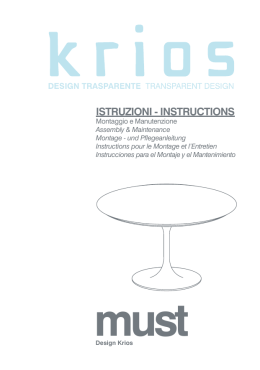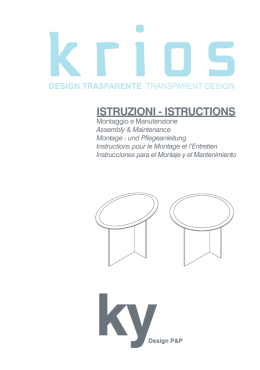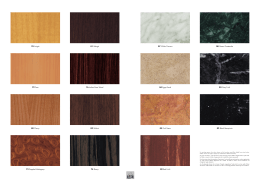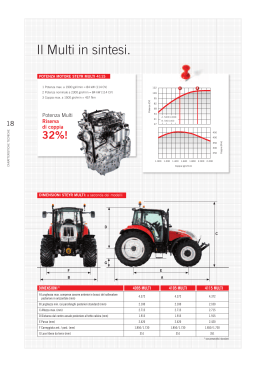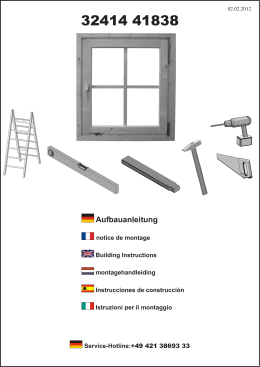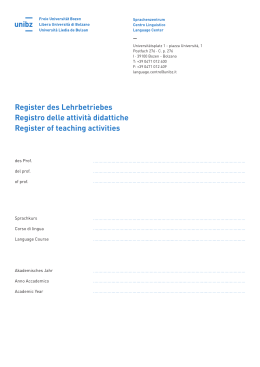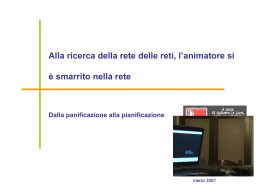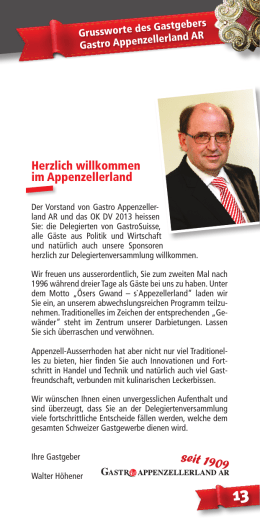QUICKSTART GUIDE ENGLISH ( 1 – 4 ) GUÍA DE INICIO RÁPIDO ESPAÑOL ( 5 – 8 ) GUIDE D'UTILISATION RAPIDE FRANÇAIS ( 9 – 12 ) GUIDA RAPIDA ITALIANO ( 13 – 16 ) KURZANLEITUNG DEUTSCH ( 17 – 20 ) WWW.AKAIPRO.COM BOX CONTENTS • Miniak • Gooseneck microphone • Power adapter • Quickstart Guide • Reference Manual • Safety Instructions & Warranty Information Booklet CONNECTION DIAGRAM Stereo Amp External Instrument Headphones Gooseneck Microphone Power Expression Pedal External Sound Module Footswitch External MIDI Device CONNECTING AC POWER Before making any power connections, make sure the Miniak’s power switch is turned off. Then, plug the power adapter into the Miniak’s power input and into a power outlet. MAKING AUDIO CONNECTIONS STEREO: Connect two cables from the Miniak’s left and right outputs to two inputs of an amp or mixer. HEADPHONES: Plug a set of headphones into the headphone jack on the rear panel. CONNECTING THE FOOT PEDALS Connect a keyboard sustain pedal (not included) to the (SUSTAIN) input. When you turn the Miniak on, the Miniak will automatically sense and calibrate itself to the pedal. You can plug an optional continuous controller expression pedal into the (EXPRESSION) input. 1 OVERVIEW OF THE CONTROLS 2 1 1 9 3 3 3 8 6 7 4 18 14 15 13 12 11 10 16 17 5 REAL-TIME CONTROLLERS Despite its small size, the Miniak has six powerful real-time controllers. These controls put the incredible expressivity of virtual analog synthesis at your fingertips. 1. (MOD1) and (MOD2) wheels: The (MOD1) wheel generally adds vibrato. (MOD2) most often sweeps the filter. 2. (PITCH) wheel: The (PITCH) wheel typically raises or lowers the pitch by a whole step, allowing you to gently or heavily detune your sound. 3. (X/Y/Z) knobs: The (X/Y/Z) knobs have different effects depending upon the program. PERFORMANCE CONTROLS The performance buttons are clustered together to the left of the display. 4. [OCTAVE]: Extend the Miniak’s playing range by using the two [OCTAVE] buttons. Each press of the [DOWN] or [UP] button shifts the transposition by one octave. The appropriate button glows with increasing intensity as the octave transposition increases. 5. [TAP TEMPO]: The [TAP TEMPO] LED always blinks at the current tempo. Tap this button at the desired rate to determine the tempo. (For finer control, you can also hold down [TAP TEMPO] and turn the control knob.) 6. [PHRASE ARP]: Use [PHRASE ARP] to capture and play back riffs that you play on the keyboard. 7. [LATCH ARP]: [LATCH ARP] acts like a sustain pedal. When [LATCH ARP] is selected, notes continue to play even after you remove your hands from the keyboard. Press [LATCH ARP] a second time to turn the function off. 8. [PATTERN PLAY]: [PATTERN PLAY] works along with Multis. When [PATTERN PLAY] is glowing, the accompaniment feature is active, allowing you to trigger Sequences and Rhythms within Multi Mode. When [PATTERN PLAY] is not glowing, all sequencing features are disabled, and the Miniak only plays the keys you press. 9. MIC INPUT: Connect the included gooseneck microphone to this input. (Note that the microphone will be bypassed when the left audio input is being used.) 2 PROGRAM CONTROLS The Program Control buttons access the Miniak’s four different modes: Programs, Rhythms, Sequences, and Multi. Press one of the buttons to enter its mode. Then spin the DATA DIAL for different sounds. 10. PROGRAMS: Programs are the heart of the Miniak – its lead, bass, drum, pad, and other virtual analog sounds. To jump to a Program category, hold down the [PROGRAMS] button while pressing the appropriate white key on the keyboard. The "recent" category remembers the most recent Programs you’ve used. Add a Program to the "faves" category by pressing the DATA DIAL twice. 11. RHYTHMS: Drum grooves comprised of one or more drum sounds, each playing its own rhythm. Play the left side of the keyboard to hear the complete groove. Trigger individual drums using the keys on the right side. 12. SEQUENCES: Melodic passages that you can compose and then trigger chromatically, beginning on any key. 13. MULTI: The Miniak’s most powerful and sophisticated mode, simultaneously combining multiple programs, rhythms, sequences, and more into powerful and expressive combinations. DATA & VOLUME CONTROLS 14. DATA DIAL: This dial can also be used to increment and decrement values and settings. 15. VOLUME KNOB: Adjusts the Miniak's master volume level. 16. [CONFIG]: The Miniak’s configuration options. Global transposition and tuning, keyboard velocity curve, MIDI settings, and more. 17. [STORE]: The [STORE] button lights when you have made edits. Press it to save your changes. 18. LCD: The display is used for navigating menus, displaying data, and affecting change on Miniak's options and parameters. SHORTCUTS PRESS-AND-HOLD SHORTCUTS FOR THE PROGRAM CONTROLS Hold down one of the [PROGRAMS], [RHYTHMS], [SEQUENCES] or [MULTI] buttons while playing the keyboard to access various editing and selection shortcuts. The text printed just above the keyboard provides a key to many of these shortcuts. Programs Select a category Edit this parameter for the current Program Multi Select a category for the most recent part Edit part A–G Edit beat A–C Sequences Select a category for the current Sequence's Program (no shortcut) Rhythms Edit drum A–G (no shortcut) 3 (no shortcut) MODE-JUMPING SHORTCUTS Access each of these shortcuts by holding one of the [PROGRAMS], [RHYTHMS], [SEQUENCES] or [MULTI] buttons and then pressing one of the other buttons. [PROGRAMS] Press [MULTI]: set the most recent part’s Program. Press [SEQUENCES]: set the Sequence’s Program. Press [RHYTHMS]: set the most recent drum’s Program (for drum Programs only). [MULTI] Press [PROGRAMS]: jump to the most recent part’s Program. Press [SEQUENCES]: jump to the Sequence of the most recent part (if any). Press [RHYTHMS]: jump to the Rhythm of the most recent beat (if any). [SEQUENCES] Press [PROGRAMS]: jump to the Sequence’s Program. Press [MULTI]: set the most recent part’s Sequence. Press [RHYTHMS]: (no shortcut). [RHYTHMS] Press [PROGRAMS]: jump to the Program of the most recent drum. Press [MULTI]: set the most recent beat’s Rhythm. Press [SEQUENCES]: (no shortcut). OTHER SHORTCUTS In most areas, pressing the control knob twice (double-click) restores the default value. Button-specific shortcuts: [OCTAVE]: Press both [OCTAVE] buttons simultaneously to return to the default octave range of C3 through C6. [TAP TEMPO]: Hold [TAP TEMPO] and turn the control knob for fine control over the tempo. [PROGRAMS]: When editing a parameter, hold down the control knob and wiggle an (X/Y/Z) knob to assign the knob to that parameter. [MULTI]: For each part, hold down [MULTI] and move a slider or the pitch wheel to jump to the controller assignment options for that part. Do the same with the (X/Y/Z) knobs. EDITING ON THE MINIAK Right out of the box, the Miniak offers all the great sounds and operation that most users will ever want. But, if you’re a "power user," you’ll find a wealth of easy-to-access editing capabilities. To dig deep into the Miniak’s capabilities, push the DATA DIAL to edit the parameters associated with the current operating mode (Programs, Multi, Sequences, Rhythms, or Config). The current mode’s light will glow red once you begin editing. Turn the DATA DIAL to cycle through various parameters. Push and turn the DATA DIAL to edit; push once more to accept your changes. The [STORE] button lights when you have made edits. Press it to save your changes. Push the DATA DIAL twice in quick succession to reset a parameter to its default (factory) value. For much more detail on editing, see the Reference Manual. 4 CONTENIDO DE LA CAJA • Miniak • Micrófono cuello de cisne • Adaptator de alimentación • Guía de inicio rápido • Manuale de referencia • Folleto de información sobre la seguridad y la garantía DIAGRAMA DE CONEXIÓN Amplificador estéreo Instrumento externo Auriculares Micrófono cuello de cisne Alimentación Pedal de expresión Módulo de sonido externo Interruptore de pedal Dispositivo MIDI externo CONEXION DE LA FUENTE DE CORRIENTE ALTERNA Antes de realizar cualquier conexión eléctrica, asegúrese de que el interruptor de alimentación del Miniak esté desconectado. Luego, conecte el adaptador de alimentación a la entrada de alimentación del Miniak y a un tomacorriente. CONEXIONES DE AUDIO Estéreo. Conecte dos cables desde las salidas derecha e izquierda del Miniak a dos entradas de un amplificador o mezclador. Auriculares. Enchufe unos auriculares en el jack de auriculares situado en el panel trasero. CONEXION DE LOS PEDALES Conecte un pedal de sostenido del teclado (no incluido) a la entrada (SUSTAIN). Cuando encienda el Miniak, el equipo detectará automáticamente el pedal y se calibrará para este último. Puede enchufar un pedal de expresión opcional con controlador continuo en la entrada (EXPRESSION). 5 DESCRIPCIÓN GENERAL DE LOS CONTROLES 2 1 1 9 3 3 3 8 6 7 4 18 14 15 13 12 11 10 16 17 5 CONTROLES DE TIEMPO REAL A pesar de su pequeño tamaño, el Miniak cuenta con seis controladores potentes de tiempo real. Estos controles le ponen al alcance de la mano la increíble expresividad de la síntesis analógica virtual. 1. Ruedas (MOD1) y (MOD2): La rueda (MOD1) normalmente agrega vibrato. (MOD2) suele barrer el filtro. 2. rueda (PITCH): La rueda (PITCH) típicamente aumenta o disminuye el pitch por un paso entero, lo que le permite desafinar su sonido suavemente o en gran medida. 3. botones (X/Y/Z): Los botones (X/Y/Z) tienen diferentes efectos según el programa. CONTROLES DE RENDIMIENTO Los botones de rendimiento están agrupados a la izquierda de la pantalla. 4. [OCTAVE]: Extienda el rango de sonido del Miniak usando los dos botones [OCTAVE]. Cada vez que presiona el botón [DOWN] o [UP] cambia la transposición en una octava. El botón correspondiente se ilumina más fuerte cada vez que la transposición de octavas aumenta. 5. [TAP TEMPO]: El LED [TAP TEMPO] parpadea al tempo actual. Golpee este botón al ritmo deseado para determinar el tempo. (Para un control más fino, puede mantener presionado [TAP TEMPO] y girar el BOTÓN DATA.) 6. [PHRASE ARP]: Use [PHRASE ARP] para capturar y reproducir melodías que toque en el teclado. 7. [LATCH ARP]: [LATCH ARP] actúa como un pedal de sostenido. Cuando selecciona [LATCH ARP], las notas continúan reproduciéndose después de que retire las manos del teclado. Presione [LATCH ARP] una segunda vez para apagar esta función. 8. [PATTERN PLAY]: [PATTERN PLAY] funciona junto con los ajustes. Cuando [PATTERN PLAY] se ilumina, la característica de acompañamiento está activa, lo que le permite disparar Secuencias y Ritmos dentro del Modo de Multi. Cuando [PATTERN PLAY] no está iluminado, todas las características de secuencia están deshabilitadas y el Miniak reproduce solamente los tonos que presione. 9. ENTRADA DE MICRÓFONO: Conecte a esta entrada el micrófono cuello de cisne incluido. (Tenga en cuenta que se puentea el micrófono cuando se usa la entrada de audio izquierda.) 6 CONTROLES DE PROGRAMA Los botones de controles de programa acceden a los diferentes modos del Miniak: Programas, Ritmos, Secuencias, y Multi. Presione uno de los botones para entrar en ese modo. Luego gire el BOTÓN DATA para obtener diferentes sonidos. 10. PROGRAMS: Los Programas son el corazón del Miniak – sus sonidos de lead, bass, batería, pad y otros sonidos virtuales análogos. Para saltar a una categoría de Programas, mantenga presionado el botón [PROGRAMS] mientras presiona la tecla blanca correspondiente en el teclado. La categoría de recientes o "recent" recuerda los Programas más recientes que ha usado. Agregue un Programa a la categoría de “faves” (favoritos) presionando el BOTÓN DATA dos veces. 11. RHYTHMS: Ritmos groove de baterías que consisten de uno o más sonidos de baterías, cada una tocando su propio ritmo. 12. SEQUENCES: Pasajes melódicos que puede componer y luego disparar cromáticamente, comenzando por cualquier tono. 13. MULTI: El modo más sofisticado y más potente del Miniak, que combina simultáneamente Programas múltiples, Ritmos, Patrones y más funciones en combinaciones potentes y expresivas. Toque la parte izquierda del teclado para escuchar el sonido entero. Dispare baterías individuales usando las teclas del lado derecho. CONTROLES DE DATA Y VOLUMEN 14. BOTÓN DATA – Este botón también se puede usar para incrementar y disminuir valores y ajustes. 15. BOTÓN VOLUMEN – Ajusta el nivel de volumen maestro del Miniak. 16. [CONFIG]: Opciones de configuración del Miniak. Transposición global y afinamiento, curva de velocidad del teclado, ajustes de MIDI y otras más. 17. [STORE]: El botón de almacenamiento [STORE] se ilumina cuando realiza ediciones. guardar sus cambios. 18. LCD: La pantalla se usa para navegar por los menús, mostrar datos y realizar cambios en las opciones y parámetros del Miniak. Presiónelo para ATAJOS PRESIONE Y MANTENGA PRESIONADO LOS ATAJOS PARA EL CIRCULO DE CONTROLES DE PROGRAMA Mantenga presionado uno de los botones de [PROGRAMS], [RHYTHMS], [SEQUENCES] o [MULTI] mientras toca el teclado para acceder varios atajos de edición y selección. El texto impreso justo arriba del teclado proporciona una tecla para varios de estos atajos. Programs Seleccione una categoría Editar este parámetro para el Programa actual Multi Seleccione una categoría para la parte más reciente Editar parte A–G Editar batería A–C Sequences Seleccione una categoría para el Programa actual de la Sequencia (no hay atajo) Rhythms Editar batería A-G (no hay atajo) 7 (no hay atajo) ATAJOS PARA SALTOS DE MODO Acceda a cada uno de estos atajos manteniendo pulsado uno de los botones [PROGRAMS], [RHYTHMS], [SEQUENCES] o [MULTI] y pulsando uno de los otros botones. [PROGRAMS] Pulse [MULTI]: para establecer el Programa de la parte más reciente. Pulse [SEQUENCES]: para establecer el Programa de la Secuencia. Pulse [RHYTHMS]: para establecer el Programa de tambor más reciente (sólo para programas de tambor). [MULTI] Pulse [PROGRAMS]: para saltar al Programa de la parte más reciente. Pulse [SEQUENCES]: para saltar al Secuencia de la parte más reciente (si existe). Pulse [RHYTHMS]: para saltar al Ritmo del beat más reciente (si existe). [SEQUENCES] Pulse [PROGRAMS]: para saltar al Programa de Secuencias. Pulse [MULTI]: para establecer el Programa de la parte más reciente. Pulse [RHYTHMS]: (no hay atajo). [RHYTHMS] Pulse [PROGRAMS]: para saltar al Programa del tambor más reciente. Pulse [MULTI]: para establecer el Ritmo del beat más reciente. Pulse [SEQUENCES]: (no hay atajo). OTROS ATAJOS En la mayoría de las áreas, al pulsar la perilla de control dos veces (doble clic), se restaura el valor predeterminado. Atajos específicos de botones: [OCTAVE]: Pulse simultáneamente ambos botones [OCTAVE] para volver al rango de octavas por defecto de Do central (C3) a Do de la 6ta octava (C6). [TAP TEMPO]: Mantenga pulsado [TAP TEMPO] y gire la perilla de control para realizar el control fino del tempo. [PROGRAMS]: Cuando edite un parámetro, mantenga presionada la perilla de control y mueva una perilla (X/Y/Z) para asignar la perilla a ese parámetro. [MULTI]: Para cada parte, mantenga pulsado [MULTI] y mueva un cursor o la rueda de pitch para saltar a las opciones de asignación del controlador correspondientes a esa parte. Haga lo mismo con las perillas (X/Y/Z). EDITAR DESDE EL MINIAK Desde la caja, el Miniak ofrece todos los sonidos y la operación que la mayoría de usuarios desean siempre. No obstante, si es un "usuario de potencia," encontrará una riqueza de capacidades de edición con fácil acceso. Para acceder todas las capacidades del Miniak, presione el BOTÓN DATA para editar los parámetros asociados con el modo de funcionamiento actual (Programas, Multis, Secuencias, Ritmos o Config). La luz del modo actual se iluminará en rojo cuando empiece a editar. El botón de almacenamiento [STORE] se ilumina cuando realiza ediciones. Presiónelo para guardar sus cambios. Gire el BOTÓN DATA para ciclar por los diversos parámetros. Presione y gire el BOTÓN DATA para editar; presione otra vez para aceptar sus cambios. Presione el BOTÓN DATA dos veces rápidamente para reajustar un parámetro a su valor predeterminado de fábrica. Para ver más detalles sobre la edición, consulte el manual de referencia. 8 CONTENU DE LA BOÎTE • Miniak • Microphone directionnel • Câble d'alimentation • Guide d'utilisation simplifié • Guide de référence • Le livret des consignes de sécurité et des informations concernant la garantie SCHÉMA DE CONNEXION Instrument externe Amplificateur stéréo Casque d'écoute Microphone directionnel Alimentation électrique Pédale d'expression Commutateur au pied Module de son externe Appareil MIDI externe BRANCHEMENT ELECTRIQUE Avant d'effectuer tout branchement, veuillez vous assurer que l'interrupteur d'alimentation du Miniak est hors tension. Branchez ensuite l’adaptateur c.a. dans l’entrée d’alimentation du Miniak et ensuite dans une prise d’alimentation murale. CONNECTIQUE AUDIO Stéréo. Branchez deux câbles des sorties gauches et droits du Miniak aux deux entrées d'un amplificateur ou d’une console de mixage. Casque d'écoute. Branchez un casque d'écoute dans la prise pour casque du panneau arrière. BRANCHEMENT DE PEDALES Branchez une pédale de soutien (non incluse) à l’entrée de soutien (SUSTAIN). Dès qu’il est mis sous tension, le Miniak détecte automatiquement la pédale et procède au calibrage. Il est aussi possible de brancher une pédale d’expression progressive dans l'entrée d’expression (EXPRESSION). 9 SURVOL DES COMMANDES 2 1 1 9 3 3 3 8 6 7 4 18 14 15 13 12 11 10 16 17 5 COMMANDES EN TEMPS RÉEL Malgré sa petite taille, le Miniak possède six contrôleurs en temps réel puissants. Ces commandes mettre l'incroyable expressivité de la synthèse analogique virtuelle à votre portée. 1. Roue (MOD1) et (MOD2) : La roue (MOD1) ajoute généralement du vibrato. Le (MOD2) s’affaire généralement au balayage du filtre. 2. Roue de tonalité (PITCH) : La roue de tonalité (PITCH) augmente ou diminue la tonalité d’un ton, vous permettant de désaccorder légèrement ou grandement le son. 3. Boutons (X/Y/Z) : sélectionné. Les boutons (X/Y/Z) peuvent avoir différents effets en fonction du programme COMMANDES DE PERFORMANCE Les touches de performance sont regroupées à la gauche de l’écran d’affichage. 4. [OCTAVE] : Augmentez le registre du Miniak à l'aide des deux touches [OCTAVE]. La transposition est modifiée d’une octave chaque fois que le touches [DOWN] ou [UP] sont enfoncées. La touche appropriée illumine avec plus d’intensité lorsque la transposition d’octave augmente. 5. [TAP TEMPO] : Le témoin DEL de la touch [TAP TEMPO] clignote toujours au tempo en cours. Tapez cette touche au rythme désiré afin de régler le tempo. (Pour un réglage plus précis, il est possible de maintenir enfoncée la touché [TAP TEMPO] et de toumer le BOUTON DATA.) 6. [PHRASE ARP] : Utilisez la touche [PHRASE ARP] pour mémoriser et faire rejouer des riffs que vous jouez sur le clavier. 7. [LATCH ARP] : La touche [LATCH ARP] agit comme une pédale de soutien. Lorsque la touche [LATCH ARP] est sélectionnée, des notes continuent à jouer même après que vous ayez cessé de jouer sur le clavier. Appuyez de nouveau sur la touche [LATCH ARP] pour annuler la fonction. 8. [PATTERN PLAY] : Le témoin [PATTERN PLAY] fonctionne en combinaison avec les différents réglages. Lorsque le témoin [PATTERN PLAY] est allumé, la fonction d’accompagnement est active vous permettant de lancer des Enchaînements et des Rythmes en Mode Multi. Lorsque le témoin [PATTERN PLAY] est éteint, toute fonction d’Enchaînement est désactivée et le Miniak ne joue que les notes que vous pressez. 9. ENTRÉE MICRO : Cette entrée permet de brancher le microphone directionnel inclus. (Veuillez noter que le microphone sera mis en mode dérivation lorsque l'entrée audio gauche est utilisée.) 10 COMMANDES DE PROGRAMME Les touches des commandes de programme accèdent aux modes différents du Miniak : Programs (Programmes), Rhythms (rythmes), Sequences (séquences) et Multi. Appuyez sur la touche qui correspond au mode que vous désirez utiliser. Faites tourner ensuite le BOUTON DATA pour des sons différents. 10. 11. 12. 13. PROGRAMS : Les programmes sont le coeur du Miniak; lead, bass, drum, pad et autres sons analogues virtuels. Pour changer de catégorie de programme, maintenez enfoncée la touche [PROGRAMS] tout en enfonçant la note blanche appropriée sur le clavier. La dernière catégorie se souvient des derniers programmes utilisés. Ajoutez un programme à la catégorie des favoris en appuyant deux fois sur le BOUTON DATA. RHYTHMS : Des séquences de batterie composées d’un ou de plusieurs sons de batterie, chacun jouant à son propre rythme. SEQUENCES : Des passages mélodieux que vous pouvez composer et ensuite lancer chromatiquement à l’aide de n'importe quelle note. MULTI : Le mode le plus puissant et sophistiqué du Miniak est d’utiliser simultanément de multiples Programmes, Rythmes, Enchaînements et plus, dans des combinaisons puissantes et expressives. Jouez le côté gauche du clavier pour écouter la séquence au complet. Lancer des séquences de batterie individuelles à l'aide du côté droit du clavier. COMMANDES DE DATA ET VOLUME 14. 15. 16. 17. 18. BOUTON DATA – Ce bouton permet également d’augmenter ou de diminuer les valeurs et les réglages. BOUTON VOLUME – Touche permettant d'ajuster le niveau du volume. [CONFIG]: Les options de configuration du Miniak. La transposition et la syntonisation globale, la vitesses du clavier, les paramètres MIDI, et plus. [STORE]: La touche de mémorisation [STORE] s’allume lorsque vous effectuez des modifications. Enfoncez-la pour sauvegarder les modifications. ACL: Afficheur ACL utilisé pour la navigation des menus, affichage des données, des options et paramètres du Miniak. RACCOURCIS DES TOUCHES DE RACCOURCI DE TYPE « ENFONCEZ ET MAINTENEZ » DES COMMANDES DE PROGRAMME Maintenez enfoncé un des boutons de programmes [PROGRAMS], de rythmes [RHYTHMS], de séquences [SEQUENCES], ou de [MULTI] en jouant du clavier pour accéder à plusieurs raccourcis d’édition et de sélection. Le texte écrit au-dessus du clavier vous offre une légende pour certains de ces raccourcis. Programs Sélectionner une catégorie Modifier les paramètres du Programme en cours Multi Sélectionner une catégorie pour la partie la plus Modifier partie A-G Modifier batterie A-C Sequences Sélectionner une catégorie pour le Programme d'Enchaînement en cours (aucun raccourci) Rhythms (aucun raccourci) Modifier batterie A-G 11 (aucun raccourci) RACCOURCIS Vous pouvez accéder aux raccourcis en maintenant les touches [PROGRAMS], [RHYTHMS], [SEQUENCES] ou [MULTI] enfoncées tout en appuyant sur une des autres touches. [PROGRAMS] Appuyez sur [MULTI] : permet de régler le Programme de la partie la plus récente. Appuyez sur [SEQUENCES] : permet de régler le Programme des Enchaînements Appuyez sur [RHYTHMS] : permet de régler le Programme de batterie le plus récent (programme de batterie seulement). [MULTI] Appuyez sur [PROGRAMS] : pour accéder directement au Programme de la partie la plus récente. Appuyez sur [SEQUENCES] : pour accéder directement à l’Enchaînement de la partie la plus récente (s’il y a lieu). Appuyez sur [RHYTHMS] : pour accéder directement au Rythme du battement le plus récent (s’il y a lieu). [SEQUENCES] Appuyez sur [PROGRAMS] : pour accéder directement au Programme de l’Enchaînement. Appuyez sur [MULTI] : pour régler le Programme de la partie la plus récente. Appuyez sur [RHYTHMS] : (aucun raccourci). [RHYTHMS] Appuyez sur [PROGRAMS] : pour accéder directement au Programme de batterie le plus récent. Appuyez sur [MULTI] : pour régler le Rythme le plus récent. Appuyez sur [SEQUENCES] : (aucun raccourci). AUTRES RACCOURCIS Dans la plupart des cas, appuyer deux fois sur le bouton de commande (double-cliquer) permet de réinitialiser les valeurs par défaut. Raccourcis spécifiques aux touches : [OCTAVE] : Appuyez sur les deux touches [OCTAVE] simultanément afin de réinitialiser la plage d’octave par défaut de C3 à C6. [TAP TEMPO] : (Pour un réglage plus précis, maintenez la touche [TAP TEMPO] enfoncée et tournez le bouton de commande.) [PROGRAMS] : Lors de l'édition d'un paramètre, maintenez le bouton de commande enfoncé et tournez un des potentiomètres rotatifs (X/Y/Z) afin d’assigner le paramètre à ce potentiomètre. [MULTI] : Pour chaque partie, maintenez la touche [MULTI] et déplacez le potentiomètre ou tournez la molette PITCH afin d’accéder aux options d’assignation du contrôleur pour cette partie. Faites de même pour les potentiomètres rotatifs (X/Y/Z). FAIRE DES MODIFICATIONS À L'AIDE DU MINIAK Le Miniak offre tous les sons et fonctions extraordinaires que la plupart des utilisateurs désirent, et ce à la portée de la main. Par contre, si vous êtes de ceux qui aiment expérimenter un peu plus, vous trouverez une mine de fonctions d’édition. Pour utiliser les fonctions plus poussées du Miniak, appuyez sur le BOUTON DATA pour modifier les paramètres associés avec le mode de fonctionnement en cours (Programs, Multis, Sequences, Rhythms ou Multi). Le témoin du mode en cours s’illumine en rouge lorsque vous procédez à des modifications. La touche de mémorisation [STORE] s’allume lorsque vous effectuez des modifications. Enfoncez-la pour sauvegarder les modifications. Tournez le BOUTON DATA pour faire défiler les différents paramètres. Appuyez puis tournez sur le BOUTON DATA pour éditer; appuyez à nouveau pour accepter les modifications. Appuyez deux fois rapidement sur le BOUTON DATA pour remettre les valeurs d’usine du paramètre. Pour plus de détail sur la fonction d’édition, veuillez consulter le guide de référence. 12 CONTENUTI DELLA CONFEZIONE • Miniak • Microfono a collo d’oca • Adattatore di alimentazione • Guida rapida • Manuale di riferimento • Libretto di istruzioni di sicurezza e garanzia SCHEMA DEI COLLEGAMENTI Amp Stereo Strumento Esterno Cuffie Microfono a collo d’oca Alimentazione Pedale d’espressione Modulo sonoro esterno Interruttore a pedale Dispositivo MIDI esterno COLLEGAMENTO ALIMENTAZIONE CA Prima di effettuare qualsiasi collegamento all'alimentazione, assicuratevi che l'interruttore di alimentazione del Miniak sia spento. Quindi, inserire l’adattatore di alimentazione all'ingresso di alimentazione del Miniak e ad una presa di corrente. COLLEGAMENTI AUDIO Stereo. Collegare due cavi a partire dalle uscite sinistra e destra del Miniak ai due ingressi di un amp o di un mixer. Cuffie. Inserire un set di cuffie nel jack cuffie situato sul pannello posteriore. COLLEGAMENTO DEI FOOT PEDAL Collegare un pedale di sostegno da tastiera (non incluso) all’ingresso (SUSTAIN). Al momento dell’accensione del Miniak, il Miniak rileverà automaticamente il pedale e si calibrerà su di esso. È inoltre possibile inserire un pedale di espressione a controllo continuo opzionale all’ingresso (EXPRESSION). 13 PANORAMICA DEI COMANDI 2 1 1 9 3 3 3 8 6 7 4 18 14 15 13 12 11 10 16 17 5 COMANDI IN TEMPO REALE Nonostante le sue dimensioni compatte, il Miniak è dotato di sei potenti comandi in tempo reale. Questi comandi conferiscono alle vostre dita tutta l’eccezionale espressività della sintesi analogica virtuale. 1. Rotelle (MOD1) e (MOD2): La rotella (MOD1) solitamente aggiunge il vibrato. (MOD2) più spesso spazza il filtro. 2. Rotella del (PITCH): La rotella del (PITCH) tipicamente aumenta o diminuisce l’intensità del pitch di un’intera fase, consentendo di desintonizzare il suono delicatamente o pesantemente. 3. Manopole (X/Y/Z): Alle manopole (X/Y/Z) sono assegnati diversi effetti a seconda del programma. COMANDI DI PRESTAZIONE I tasti di prestazione sono raggruppati a sinistra del display. 4. [OCTAVE]: È possibile estendere l’ampiezza di riproduzione del Miniak servendosi dei due tasti [OCTAVE]. Ad ogni pressione del tasto [DOWN] o [UP] si passa alla trasposizione di un’ottava. Il giusto tasto si illumina sempre più all’aumentare della trasposizione delle ottave. 5. [TAP TEMPO]: Il LED [TAP TEMPO] lampeggia sempre al tempo corrente. Battere il pulsante al tempo desiderato per determinare il tempo. (Per un controllo più fine, è anche possible mantenere la pressione sul tasto [TAP TEMPO] e girare la MANOPOLA DATA.) 6. [PHRASE ARP]: Servirsi di [PHRASE ARP] per cogliere e riprodurre i riff che vengono suonati sulla tastiera. 7. [LATCH ARP]: [LATCH ARP] funziona come un pedale di sostegno. Quando [LATCH ARP] è selezionato, le note continuano a suonare anche dopo aver tolto le mani dalla tastiera. Premere [LATCH ARP] una seconda volta per spegnere la funzione. 8. [PATTERN PLAY]: [PATTERN PLAY] funziona con le impostazioni. Quando [PATTERN PLAY] si illumina, la funzione di accompagnamento è attiva, permettendovi di innescare Sequenze e Ritmi all’interno della Modalità di Multi. Quando [PATTERN PLAY] non è illuminato, tutte le funzioni di sequenziamento sono disabilitate, ed il Miniak suona unicamente i tasti che vengono premuti. 9. INGRESSO MIC: collegare il microfono a collo d’oca in dotazione a questo ingresso. (Va notato che il microfono verrà bypassato quando viene utilizzata il ingresso audio di sinistra.) 14 COMANDI DI PROGRAMMA Il tasti del comandi di programma accedono alle diverse modalità del Miniak: Programs (programmi), Rhythms (ritmi), Sequences (sequenze) e Multi. Premere uno dei tasti per entrare in quella determinata modalità. Quindi far ruotare la MANOPOLA DATA per ricercare i diversi suoni. 10. 11. 12. 13. PROGRAMS: I programmi sono il cuore del Miniak – i suoi ottoni, bassi, percussioni, pad, ed altri suoni analogici virtuali. Per saltare ad una determinata categoria di Programma, mantenere la pressione sul tasto [PROGRAMS] premendo contemporaneamente il tasto bianco adatto sulla tastiera. La categoria "recent" ricorda i Programmi da voi utilizzati di recente. È possibile aggiungere un Programma alla categoria "faves" (favoriti) premendo due volte il MANOPOLA DATA. RHYTHMS: Groove di percussioni che comprendono uno o più suoni di percussioni che suonano ciascuno al proprio Ritmo. Suonare la parte sinistra della tastiera per ascoltare l'interna gamma del groove. Innescare le single percussioni servendovi dei tasti situati sul lato destroy. SEQUENCES: Passaggi melodici che potete comporre ed avviare cromaticamente, iniziando con qualsiasi tasto. MULTI: La modalità più potente e sofisticata del Miniak, che combina simultaneamente programmi multipli, ritmi, schemi e più, in combinazioni potenti ed espressive. COMANDI DI DATA E VOLUME 14. 15. 16. 17. 18. MANOPOLA DATA – Questa rotella può a sua volta essere utilizzata per aumentare e diminuire i valori e le impostazioni. MANOPOLA VOLUME – Regola il livello del volume principale del Miniak. [CONFIG]: Le opzioni di configurazione del Miniak. Trasposizione globale e sintonia, curva di velocità della tastiera, impostazioni MIDI e molto altro. [STORE]: Il tasto [STORE] si illumina in seguito all’apporto di modifiche. Premere questo tasto per salvare le modifiche. LCD: Il display serve per navigare tra i menu, visualizzare i dati ed apportare modifiche alle opzioni e ai parametri del Miniak. SCORCIATOIE SCORCIATOIE "PREMI-E-MANTIENI" PER IL CERCHIO DELLA COMANDI DI PROGRAMMA Mantenere la pressione su uno dei seguenti tasti: [PROGRAMS], [RHYTHMS], [SEQUENCES] o [MULTI] suonando la tastiera per accedere a varie scorciatoie di editing e di selezione. Il testo stampato al di sopra della tastiera fornisce una chiave a molte di queste scorciatoie. Programs Selezionare una categoria Editare questo parametro per il Programma in corso Multi Selezionare una categoria per la parte più recente Editare parte A–G Editare percussioni A–C Sequences Selezionare una categoria all'interno del Programma del Sequenza in corso (nessuna scorciatoia) Rhythms (nessuna scorciatoia) Editare percussioni A–G 15 (nessuna scorciatoia) SCORCIATOIE PER IL PASSAGGIO DA UNA MODALITÀ ALL’ALTRA Accedere a ciascuna di queste scorciatoie tenendo premuto uno dei tasti [PROGRAMS], [RHYTHMS], [SEQUENCES] o [MULTI] (Programmi, Ritmi, Sequenze e Multi) e premendo quindi uno degli altri tasti. [PROGRAMS] (programmi) Premere [MULTI]: Premere [SEQUENCES]: Premere [RHYTHMS]: imposta il Programma della parte più recente. imposta il Programma del Sequenza. imposta il Programma di batteria più recente (unicamente per programmi di batteria). [MULTI] Premere [PROGRAMS]: Premere [SEQUENCES]: Premere [RHYTHMS]: passa al Programma più recente di quella parte. passa al Sequenza della parte più recente (se esistente). passa al Ritmo del beat più recente (se esistente). [SEQUENCES] (sequenze) Premere [PROGRAMS]: Premere [MULTI]: Premere [RHYTHMS]: passa al Programma del Sequenza. imposta il Sequenza della parte più recente. (nessuna scorciatoia). [RHYTHMS] (ritmi) Premere [PROGRAMS]: Premere [MULTI]: Premere [SEQUENCES]: passa al Programma delle percussioni più recenti. imposta il Ritmo del beat più recente. (nessuna scorciatoia). ALTRE SCORCIATOIE Nella maggior parte delle aree, premendo due volte la manopola di controllo (doppio clic), viene ripristinato il valore predefinito. Scorciatoie specifiche per ciascun pulsante: [OCTAVE]: premere entrambi i tasti [OCTAVE] contemporaneamente per tornare alla gamma di ottave predefinita da C3 a C6. [TAP TEMPO]: tenere premuto [TAP TEMPO] e girare la manopola di controllo per una regolazione fine del tempo. [PROGRAMS]: quando si modifica un parametro, tenere premuta la manopola di controllo e muovere una manopola (X/Y/Z) per assegnarla a quel parametro. [MULTI]: per ciascuna parte, tenere premuto [MULTI] e muovere un cursore o la rotella del pitch per passare alle opzioni di assegnazione del controller per quella determinata parte. Procedere allo stesso modo con le manopole (X/Y/Z). EDITARE CON IL MINIAK Appena fuori dalla sua confezione, il Miniak offre tutti gli eccezionali suoni e le funzioni che la maggior parte degli utenti possano desiderare. Ma, nel caso in cui siate un utente potente, troverete un’infinità di capacità di editing di facile accesso. Per indagare in profondità le capacità del Miniak, premere la MANOPOLA DATA per editare i parametri associati alla modalità operativa corrente (Programs, Multis, Sequences, Rhythms o Config). La luce relativa alla modalità in corso di esecuzione diventerà rossa quando inizierete le operazioni di editing. Il tasto [STORE] si illumina quando sono state effettuate modifiche. Premere questo tasto per salvare le modifiche apportate. Girare la MANOPOLA DATA per far scorrere i vari parametri. Premere e girare la MANOPOLA DATA per editare; premere ulteriormente per accettare le modifiche . Premere la MANOPOLA DATA due volte in successione rapida per resettare un parametro al suo valore originario (di fabbrica). Per ulteriori dettagli sull’editing, vedi il manuale di riferimento. 16 INHALT DER VERPACKUNG • Miniak • Schwanenhalsmikrophon • Netzeil • Kurzanleitung • Anleitung • Broschüre mit den Sicherheits- und Garantierichtlinien ANSCHLUSSDIAGRAMM Stereoverstärker Kopfhörer Externes Instrument Schwanenhalsmikrophon Netz Expressionpedal Pedalschalter Externes Soundmodul Externes MIDI-Gerät ANSCHLUSS AN DAS WECHSELSTROMNETZ Stellen Sie sicher, dass vor jeglichem Anschluss an eine Stromquelle der Hauptschalter des Miniak ausgeschaltet ist. Stecken Sie dann den Netzadapter in die Anschlussbuchse des Miniak und anschließend an eine Netzsteckdose. ANSCHLÜSSE ZUR TONWIEDERGABE Stereo. Schließen Sie zwei Kabel von den linken und rechten Ausgängen des Miniak an zwei Anschlüsse eines Verstärkers oder Mischpults an. Kopfhörer. Schließen Sie einen Kopfhörer an die Kopfhörerbuchse an der Rückseite des Geräts an. ANSCHLUSS DER FUßPEDALE Schließen Sie ein Sustain-Pedal für das Keyboard (nicht beinhaltet) an den Sustain-Eingang an. Sobald Sie den Miniak einschalten, wird dieser das Pedal erkennen und sich darauf abgleichen. Sie können wahlweise ein Expression-Pedal als Continuous Controller an den Expression-Eingang anschließen. 17 ÜBERBLICK ÜBER DIE BEDIENELEMENTE 2 1 1 9 3 3 3 8 18 6 7 4 14 15 13 12 11 10 16 17 5 REAL-TIME CONTROLLER Trotz seiner kleinen Größe hat der Miniak sechs leistungsfähige Echtzeit-Controller. Diese Steuerungen ermöglichen es Ihnen, der virtuellen Analogsynthese eine unglaubliche Expressivität zu verleihen. 1. Rädern (MOD1) und (MOD2): Im allgemeinen fügt der (MOD1)-Rads Vibrato hinzu. (MOD2) tastet meist den Filter ab. 2. (TONLAGE) Rad: Die typische Verwendung des (TONLAGE) Rads dient zur Hebung oder Senkung der Tonlage um eine ganze Stufe, was es Ihnen ermöglicht, Ihren Sound sanft oder stark umzustimmen. 3. (X/Y/Z)-Regler: Die (X/Y/Z)-Regler haben verschiedene, vom jeweiligen Programm abhängige Effekte. LEISTUNG-CONTROLLER Die Leistungstasten sind als Gruppe zur Linken der Anzeige angeordnet. 4. [OCTAVE]: Erweitern Sie den Spielbereich des Miniak indem Sie die beiden [OCTAVE]-Tasten benutzen. Jedes Drücken der [DOWN]- oder [UP]-Tasten führt zu einer Verlagerung um eine Oktave. Die entsprechende Taste leuchtet mit zunehmender Stärke im gleichen Maß, wie die Verlagerung zunimmt. 5. [TAP TEMPO]: Das [TAP TEMPO]-LED blinkt immer im augenblicklichen Tempo. Um das Tempo zu bestimmen, diese Taste im gewünschten Tempo antippen. (Zur Feineinstellung können Sie auch die [TAP TEMPO]-Taste gedrückt halten und den DATAREGLER drehen.) 6. [PHRASE ARP]: Verwenden Sie [PHRASE ARP] um Riffs, welche Sie auf dem Keyboard spielen, aufzunehmen und Wiederzugeben. 7. [LATCH ARP]: [LATCH ARP] funktioniert wie ein Sustain-Pedal. Wenn [LATCH ARP] gewählt wurde, werden Noten sogar nachdem Sie das Keyboard nicht weiter betätigen weitergespielt. Drücken Sie [LATCH ARP] ein zweites Mal, um diese Funktion auszuschalten. 8. [PATTERN PLAY]: [PATTERN PLAY] funktioniert zusammen mit Multis. Sobald [PATTERN PLAY] aufleuchtet, ist die Begleitfunktion aktiv und ermöglicht es Ihnen, Sequenzen und Rhythmen innerhalb des Multi-Modus auszulösen. Wenn [PATTERN PLAY] nicht aufleuchtet, bedeutet dies, dass sämtliche Reihenfolgefunktionen ausgeschaltet sind und der Miniak spielt nur die Tasten, welche Sie drücken. 9. MIC INPUT: Dieser Eingang dient zum Anschluss des beiliegenden Schwanenhalsmikrophons. (Beachten Sie, dass das Mikrophon bei Verwendung des linken Audioeingangs überbrückt wird.) 18 PROGRAMME-CONTROLLER Die Tasten des Programme-Controller ermöglichen Zugang zu den verschiedenen Betriebsarten des Miniak: Programs (Programme), Rhythms (Rhythmen), Sequences (Sequenzen) und Multi. Drücken Sie eine der Tasten, um diese Betriebsart abzurufen. Drehen Sie dann den DATAREGLER, um verschiedene Töne zu erzeugen. 10. PROGRAMS: Die Programme sind das Herzstück des Miniak - die Lead-, Bass-, Drum-, Pad- und andere virtuelle Analogtöne. Um zu einer bestimmten Programmkategorie zu gelangen, halten Sie die [PROGRAMS]Taste gedrückt, während Sie die entsprechende weiße Taste auf dem Keyboard drücken. Die Kategorie "Vorher" speichert die Programme, welche Sie kurz vorher benutzt haben. Fügen Sie ein Programm zur Kategorie "Faves" hinzu, indem Sie den DATAREGLER zweimal drücken. 11. RHYTHMS: Schlagzeug-Kompositionen, welche aus einem oder mehreren Trommeltönen bestehen, wobei jeder dieser in seinem eigenen Rhythmus spielt. Spielen Sie die linke Seite des Keyboards, um das gesamte Stück zu hören. Rufen Sie individuelle Trommeln mit den Tasten auf der rechten Seite ab. 12. SEQUENCES: Melodische Passagen, welche Sie komponieren und dann, beginnend mit einem beliebigen Ton, in Halbtönen fortschreitend abrufen können. 13. MULTI: Dies ist die stärkste und raffinierteste Betriebsart des Miniak, welche mehrere Programme, Rhythmen, Tonmuster und weitere im Simultanbetrieb zu noch leistungs- und ausdrucksfähigeren Kombinationen zusammenfügt. DATA- UND LAUTSTÄRKE-CONTROLLER 14. DATAREGLER – Dieses Regler wird auch zum Ändern von Werten oder Einstellungen verwendet. 15. LAUTSTÄRKE-REGLER – Adjustiert die Master-Lautstärke des Miniak. 16. [CONFIG]: Die Konfigurationsoptionen des Miniak. Umfassende Verlagerungen und Einstellungen, Geschwindigkeitsverlauf des Keyboards, MIDI-Einstellungen und mehr. 17. [STORE]: Die [STORE]-Taste leuchtet immer dann auf, wenn Sie editiert haben. Drücken Sie diese, um Ihre Veränderungen abzuspeichern. 18. LCD: Das Display wird zur Navigation durch Menüs, zur Datenanzeige und zur Anzeige der Werteänderungen der Optionen und Parameter des Miniak verwendet. TASTENKOMBINATIONEN SCHNELLBEDIENUNG DES PROGRAMME-CONTROLLER MIT DRÜCKEN UND FESTHALTEN Halten Sie eine der Tasten [PROGRAMS], [RHYTHMS], [SEQUENCES] oder [MULTI] gedrückt, während Sie das Keyboard bedienen, um auf verschiedene Editier- und Auswahlfunktionen zugreifen zu können. Die sich über dem Keyboard befindliche Beschriftung dient als Anleitung für viele dieser Tastenkombinationen. Programs Kategorie auswählen Parameter für gewähltes Programm editieren Multi Kategorie für zuletzt gewählten Teil auswählen Teil A-G editieren Trommel A-C editieren Sequences Kategorie für das derzeitige Programmsequenz wählen (keine Tastenkombination) Rhythms (keine Tastenkombination) Edit drum A–G 19 (keine Tastenkombination) TASTENKOMBINATIONEN FÜR SCHNELLEN MODUSWECHSEL Die nachstehenden Tastenkombinationen, bei denen eine der Tasten [PROGRAMS], [RHYTHMS], [SEQUENCES] oder [MULTI] und eine weitere Taste gedrückt werden, gestatten schnelle Moduswechsel. Mit [PROGRAMS] [MULTI] drücken: [SEQUENCES] drücken: [RHYTHMS] drücken: Mit [MULTI] [PROGRAMS] drücken: [SEQUENCES] drücken: [RHYTHMS] drücken: Programm des kurz zuvor gespielten Stückes einstellen. Programmsequenz einstellen. kurz zuvor verwendetes Schlagzeugprogramm einstellen (nur für Schlagzeugprogramme). zum Programm des zuletzt gespielten Stückes navigieren. zum Programmsequenz des zuletzt gespielten Stückes navigieren (falls vorhanden). zum Rhythmus des letzten Takts navigieren (falls vorhanden). Mit [SEQUENCES] [PROGRAMS] drücken: [MULTI] drücken: [RHYTHMS] drücken: zum Programmsequenz navigieren. Sequenz des zuletzt gespielten Stückes einstellen. (keine gültige Tastenkombination). Mit [RHYTHMS] [PROGRAMS] drücken: [MULTI] drücken: [SEQUENCES] drücken: zum Programm des zuletzt gespielten Schlagzeugs navigieren. den Rhythmus des zuletzt verwendeten Takts einstellen. (keine gültige Tastenkombination). ANDERE TASTENKOMBINATIONEN Ein zweimaliges Drücken (Doppelklick) des Steuerreglers führt in den meisten Bereichen zur Rückstellung auf den vom Werk eingestellten Wert. Tastenspezifische Kombinationen: [OCTAVE]: Werden beide [OCTAVE]-Tasten gleichzeitig gedrückt, erfolgt die Rücksetzung auf den vom Werk eingestellten Oktavbereich C3 bis C6. [TAP TEMPO]: [TAP TEMPO] gedrückt halten und durch Drehen des Steuerreglers das Tempo feineinstellen. [PROGRAMS]: Bei Änderung eines Parameters den Steuerregler gedrückt halten und durch Betätigen eines (X/Y/Z)Reglers diesen Regler dem Parameter zuordnen. [MULTI]: Für jeden Abschnitt die [MULTI]-Taste herunterdrücken und mit dem Schieberegler oder dem Tonhöhenrad zu den Optionen für die Steuerungsbelegung dieses Abschnitts navigieren. Das Gleiche kann mit den (X/Y/Z)Reglern gemacht werden. EDITIEREN MIT DEM MINIAK Kaum ausgepackt bietet der Miniak alle die coolen Sounds und Bedienfunktionen, welche die meisten Benutzer wollen. Falls Sie jedoch ein professioneller Benutzer sind, werden Sie eine Vielfalt an leicht zu bedienenden Editierfunktionen entdecken. Um die gesamten Möglichkeiten des Miniak zu erschließen, drücken Sie den DATAREGLER und können dann die mit dem augenblicklichen Betriebsmodus (Programme, Multis, Konfiguration, Tonmuster oder Rhythmen) in Verbindung stehenden Parameter editieren. Die Leuchtanzeige des augenblicklichen Betriebsmodus wird in Rot aufleuchten, sobald Sie mit dem Editieren beginnen. Die [STORE]-Taste leuchtet immer dann auf, wenn Sie Editiert haben. Drücken Sie diese, um Ihre Veränderungen abzuspeichern. Drehen Sie den DATAREGLER, um verschiedene Parameter zu durchlaufen. Drücken und drehen Sie den DATAREGLER zum Editieren; zum Bestätigen Ihrer Änderungen drücken Sie diesen erneut. Drücken Sie den DATAREGLER zweimal schnell hintereinander, um den Parameter auf den vom Werk eingestellten Wert zurückzusetzen. Wesentlich mehr Einzelheiten zum Editieren können aus der Anleitung entnommen werden. 20 TECHNICAL SPECIFICATIONS Synthesis: Polyphony: Timbrality: Oscillators: Filters: Modulation: Effects: Sequencing: Virtual analog (subtractive), noise generator, FM Up to 8 voices Up to 8 parts 3 per voice with continuously variable waveshapes, sync, linear and exponential FM, Ring Mod, routable modulation matrix per voice 2 multi-mode resonating filters per voice with 16 filter types 2 LFOs with multiple wave shapes, sample and hold, tracking generator, freelyroutable modulation matrix per voice 4 drive effects, 1 per part; master effects Step sequencer, arpeggiator, drum machine/rhythm sequencer, and phrase sequencer Program memory: Up to 1,000 programs and multi-timbral setups Velocity sensitive: Yes Keyboard: External control: Inputs: 37-key, semi-weighted MIDI in/out/thru 2 balanced 1/4” TRS, mic Outputs: 2 balanced 1/4” TRS, 1/4” TRS headphone Controls: Pitch wheel, two assignable Q-Link modulation wheels, X, Y, and Z parameter knobs, pattern play, phrase arpeggiator, latch arpeggiator, keyboard octave, tap tempo, program controls, data push-knob, config, store, master volume Pedal Inputs: Assignable expression pedal, sustain pedal 7-51-0290-A 21 WWW.AKAIPRO.COM
Scarica

